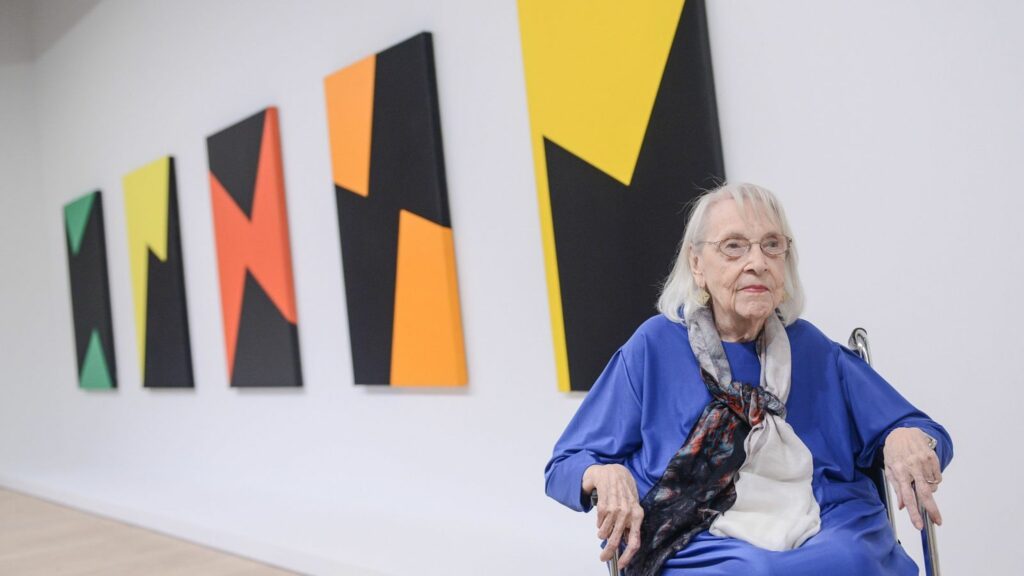
The Parrish Art Museum‘s South Meadow currently hosts a striking exhibition, Carmen Herrera: Estructuras Monumentales, featuring four large-scale sculptures in vivid hues of red, blue, yellow, and green. These sculptures are the creations of Carmen Herrera, a celebrated Cuban-American artist born in 1915, known for her precise hard-edge paintings, prints, and sculptures that often explore geometric shapes through both symmetrical and asymmetrical abstractions.
The four pieces on display, Angulo Azul (2017), Angulo Amarillo (2017), Estructura Verde (1966/2018), and Gemini (Red) (1971/2019), belong to Herrera’s Estructuras series. Initially conceived as sketches and paintings during the 1960s, these works were a part of Herrera’s vision to create monumental sculptures. In 1971, she crafted four Estructuras in wood, including three wall-based pieces and one free-standing sculpture. However, it wasn’t until the last fifteen years of her life that Herrera could bring these visions to life on a grand scale, realizing each sculpture in acrylic and aluminum to exacting standards of color and form.
These Estructuras may reflect Herrera’s experiences and identity as a Cuban-American, navigating the political tensions between her native Cuba and adopted United States. Some of the original sketches were made in 1962 during the Cuban Missile Crisis, a time when Herrera and her husband, Jesse Lowenthal, were actively helping friends and family flee the turmoil. The specific designs for Estructura Verde and Gemini (Red) date back to 1966 and 1971, respectively, while the chevron shapes of Angulo Amarillo and Angulo Azul are more recent creations from 2017.
Herrera’s Estructuras, much like her renowned dichromatic paintings, explore the interplay between positive and negative space. The sharp, wedge-shaped cutouts in each sculpture accentuate the contrast between their bold, monochromatic surfaces and the surrounding environment, drawing viewers into a dialogue with the forms.
The exhibition Carmen Herrera: Estructuras Monumentales is curated by Corinne Erni, the Lewis B. and Dorothy Cullman Chief Curator of Art and Education, and Deputy Director of Curatorial Affairs, with support from Kaitlin Halloran, Assistant Curator and Publications Coordinator.
This exhibition is made possible by the generous contributions of Tony Bechara, The Fuhrman Family Foundation, Agnes Gund, Lisson Gallery, MOVADO, Estrellita and Daniel Brodsky, Jeff Lipsitz, Allison Koffman, and their family, along with an anonymous donor. The Parrish Art Museum’s programs also receive support from the New York State Council on the Arts, Suffolk County, and local school district taxpayers.
The sculptures, set against the backdrop of the South Meadow, invite visitors to experience Herrera’s artistic journey in a profound way. The open space allows for an immersive interaction with the works, encouraging viewers to walk around and between the sculptures, gaining different perspectives and appreciating the dynamic play of light and shadow on their surfaces. This interaction enhances the understanding of Herrera’s meticulous attention to form and color, as well as her ability to transform simple geometric shapes into powerful visual statements.
In addition to the visual impact, the exhibition also serves as a testament to Herrera’s perseverance and dedication to her craft. Despite facing numerous obstacles throughout her career, including the marginalization of women artists and the challenges of being an immigrant, Herrera’s unwavering commitment to her vision ultimately allowed her to achieve international acclaim. The Estructuras Monumentales stand not only as magnificent pieces of art but also as symbols of resilience and the enduring power of creative expression.
For visitors, Carmen Herrera: Estructuras Monumentales offers a rare opportunity to engage with Herrera’s work on a monumental scale, appreciating the full realization of her lifelong artistic vision. The exhibition is a celebration of Herrera’s legacy, showcasing the profound impact of her work and her significant contributions to the art world.

Link to the original article
